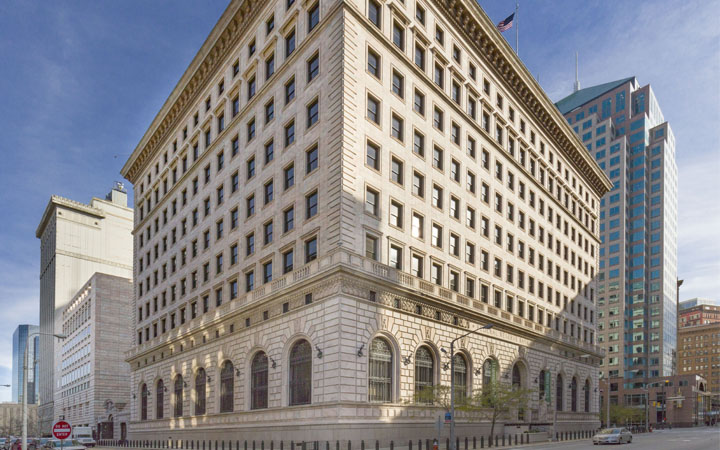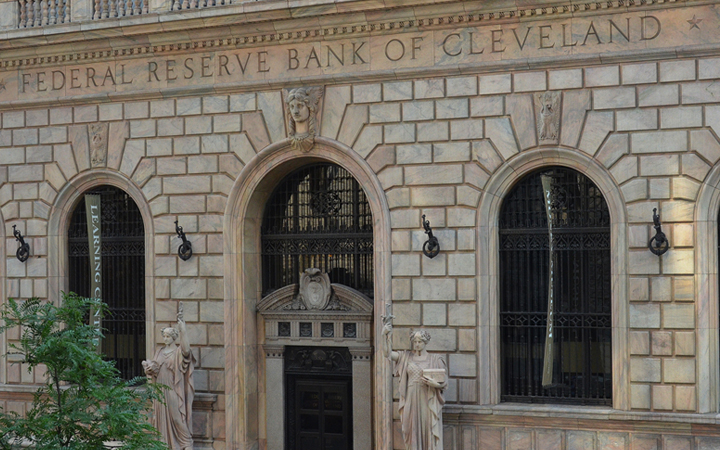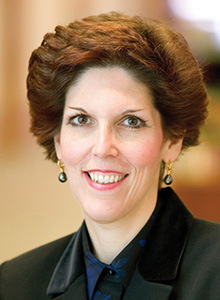Federal Reserve Bank of Cleveland
The Federal Reserve Bank of Cleveland is led by president and CEO Loretta J. Mester. The Fourth Federal Reserve District, headquartered in Cleveland, includes Ohio, western Pennsylvania, eastern Kentucky, and the northern panhandle of West Virginia.

The Federal Reserve Bank of Cleveland building
(photo Eric Hanson/©Federal Reserve Bank of Cleveland)by Federal Reserve Bank of Cleveland staff
Why Cleveland
The Federal Reserve Act of 1913, developed by members of Congress and signed into law by President Woodrow Wilson on December 23, authorized the creation of the nation’s central bank, with multiple branches to be located across the country. In February 1914, a well-organized campaign by a group of Cleveland businessmen, financiers, and politicians was instrumental in the decision to locate the Fourth District headquarters in Cleveland.
These men—J. J. Sullivan, chair of the Clearing House Committee; Newton D. Baker, mayor of Cleveland; Warren S. Hayden, president of the Cleveland Chamber of Commerce; Elbert H. Baker, president of the Plain Dealer Publishing Co.; and F. H. Goff, president of the Cleveland Trust Company—petitioned the Reserve Bank Organization Committee (RBOC) to consider Cleveland as a location for one of the 12 Reserve Banks.
During this period, Cleveland was a budding industrial city with a growing population reaching nearly 561,000 residents. In 1910, it was the sixth largest city behind Boston and St. Louis. Manufacturing, printing and publishing, iron, steel, and agriculture were its chief industries. Its proximity to smaller communities and major cities in the region and its accessibility by railroads, major highways, and Lake Erie made it an attractive and prosperous location for trade and businesses.
The city also benefitted from civic and philanthropic leaders who began to establish charities and foundations to support the city’s health and social welfare agencies, among these the Cleveland Foundation and the Cleveland Federation for Charity and Philanthropy (which developed over time to become the United Way of Greater Cleveland). These and other factors, including widespread support from 233 banks in northern and central Ohio, helped nudge the RBOC into choosing Cleveland for its fourth Reserve Bank location.
The Federal Reserve Bank of Cleveland is born
On April 2, 1914, the RBOC announced that it would establish 12 Federal Reserve Banks whose territories would be divided into Federal Reserve Districts across the country. The Reserve Bank in Cleveland would join those in 11 other cities to form the nation’s new Federal Reserve System.
Each Reserve Bank was required to establish a Reserve Bank charter outlining its principles, functions, organizational structure, and purpose. In Cleveland, 12 bank executives appointed by the RBOC and representing institutions in Cleveland, Cincinnati, and Columbus, Ohio; Lexington, Kentucky; and Pittsburgh, Pennsylvania, met on May 18, 1914, to draft and sign a formal application for a bank charter for the Fourth Federal Reserve District. All 12 Reserve Banks opened for business on November 14, 1914, just seven months after the locations were established.
Elvadore R. Fancher, a former bookkeeper and later vice president of Union National Bank of Cleveland, became the first president, at that time called a “governor” rather than a president, of the Federal Reserve Bank of Cleveland on November 2, 1914. He held the position for more than 20 years, until his death on January 16, 1935.
Grand opening, grand building

The Cleveland Reserve Bank opened with 23 employees on November 16, 1914, just two weeks after Fancher became Bank governor, in the Williamson Building, a 17-story structure on Public Square in downtown Cleveland. Federal Reserve branches were subsequently established by 1918 in Pittsburgh and Cincinnati. At that time, the Cleveland Bank was the third-largest of the 12 Reserve Banks, with total assets of $613,777, about $11 million in today’s dollars.
Banking activity grew at such speed in the Fourth District that the Cleveland Reserve Bank quickly outgrew its space. In August 1923, the Bank's Cleveland headquarters moved into a building designed by the architectural firm of Walker and Weeks and that cost $8.25 million to complete.
Constructed to reflect both safety and security, the building featured an early twentieth-century American Renaissance style and housed a bank vault with a door weighing 91 tons. Despite the door’s size and weight, it is so finely balanced that one person can move it easily. At the time of its construction, the door assembly—including the frame and crane hinge—weighed 300 tons. It is still the largest vault door in the world.
Bank personnel settled into the 13-story building on Superior Avenue and East Sixth Street in downtown Cleveland. On August 23, 1923, the day the doors to the new Federal Reserve Bank of Cleveland opened to the public, an estimated 40,000 visitors passed through the building.
The entrances to the building feature allegorical sculptures by Henry Hering to represent the values of the banking system. These include stone sculptures Security and Integrity on either side of the East Sixth Street entrance and the bronze sculpture Energy that watches the Superior Avenue employee entrance. The building is listed on the National Register of Historic Places.
A bank of firsts – women govern
For the first several decades of the Federal Reserve System’s existence, it was slow to promote women to leadership roles. While women held positions as economists, researchers, bank examiners, and administrative assistants, among others, none were Bank officers or directors.
In the December 1956 issue of Federal Reserve Notes, however, Cleveland Federal Reserve Bank President Wilbur D. Fulton announced the appointment of Anne J. Erste to assistant cashier, at that time an officer-level position, making her the first—and only—woman officer within the 12 Reserve Banks. He cited her appointment as recognition of her abilities and “of the important place women have on the staff of this Bank.” Prior to her appointment, Erste served as a personnel assistant.
It wasn’t until 1978 that the Federal Reserve added a woman to its leadership ranks. President Jimmy Carter nominated and the Senate confirmed Nancy H. Teeters to serve on the Board of Governors of the Federal Reserve System. This seven-member body guides and oversees the work of the Federal Reserve. Teeters, who first joined the Federal Reserve System as an economist, concluded her term in 1984, shortly after the Cleveland Reserve Bank, in 1982, recruited a woman to lead its enterprise: Karen Horn.
A Fed First
Karen Horn, president of the Cleveland Fed from 1982-1987, was the first woman president in the Federal Reserve System's history.
Not only was Horn the first woman president of the Cleveland Reserve Bank, but she was also the first woman president in the Federal Reserve System’s then 69-year history. Her position at the Bank also opened another door traditionally reserved for men. She was the first woman to join Cleveland's exclusive Union Club, a private club in downtown Cleveland for the city’s business and executive elite. It took a year into her role as Cleveland Reserve Bank president before she was invited to join. Horn’s club membership opened the front door for other women: Prior to her admission, women were quite literally not allowed to enter through the Union Club’s front door.
A few years into her five-year tenure, Horn helped to resolve Ohio's savings and loan crisis in 1985, when Home State Savings Bank in Cincinnati collapsed after losing millions of dollars in investments. This event set off a series of closings of dozens of privately insured savings and loan companies in Ohio.
Horn sent regulators across the state to identify these troubled institutions. And while Home State’s financial losses could not be fully recovered through insurance, she developed a plan to monitor deposits and withdrawals to prevent a future crisis. Horn came to be a respected crisis manager and strategic leader. She left in 1987 to become chair and chief executive officer of Banc One Corp. in Cleveland.
The Cleveland Reserve Bank’s tenth president and chief executive officer, Sandra Pianalto, was the second woman to lead the Cleveland Reserve Bank, beginning her tenure in February 2003. She first joined the Bank as an economist in 1983, serving during Horn’s tenure. Subsequent promotions, including to first vice president and chief operating officer roughly ten years later, led to Pianalto’s consideration for the Bank presidency.
Pianalto led during an extraordinary period in the country’s economic history, steering the Fourth District through the financial crisis and severe recession from 2008 through 2009 that saw high unemployment, stagnant wages, declines in home values, and loss of profits for businesses and nonprofit organizations. She directed the Bank to focus not only on operational excellence, but also on thought leadership, the concept of exploring ideas and processes to understand what works best to achieve the desired outcome. Pianalto completed her term in May 2014.
On the heels of Pianalto’s departure, the Cleveland Reserve Bank appointed its eleventh president and third woman to the position, Loretta J. Mester, who had been an executive vice president and the director of research at the Federal Reserve Bank of Philadelphia.
In 2021, Mester serves as an alternate voting member of the Federal Open Market Committee (FOMC), the monetary policymaking body of the Federal Reserve System. Outside the Bank, she serves on several boards in the Cleveland area, including those of the Greater Cleveland Partnership, Cleveland Clinic, the Musical Arts Association (Cleveland Orchestra), and the Council for Economic Education, among others.
To date, Cleveland has had three women presidents—more than any other Reserve Bank.
More than a Reserve Bank
The Cleveland Reserve Bank supervises four of the nation’s largest bank and savings and loan holding companies and several hundred additional financial holding companies and state-chartered member banks. Although the Bank shares similar departments and activities with many of the other Reserve Banks, of special note is its handling of collections and payments for the US Department of the Treasury and its focus on inflation research.
The Bank’s Treasury Services Department provides the latest digital products and services that allow federal agencies and partners to collect funds electronically. Its range of digital products include websites, mobile applications, and web services, using enterprise services for remittance capture, billing, user management, and fraud prevention. Its chief product is a web portal for individuals and business to make secure online payments to government agencies. The website processes transactions from electronic debits, credit cards, digital wallets, PayPal, and Amazon Pay.
People who want to know the ins and outs of inflation need look no further than the Bank’s Center for Inflation Research, a leading resource for "all things inflation." Launched in December 2018, the center offers a combination of research, analyses and data, background, and commentary on inflation and hosts an annual conference series dedicated to inflation. The information and research provided by the center is intended for readers whose interests range from staying informed about inflation developments to learning about recent theoretical and empirical work analyzing the inflation process. The center’s advisory council, comprising leading experts from the United States and abroad, offers external perspectives and input into the center’s projects and conferences.
Written by the Federal Reserve Bank of Cleveland, September 2021. See disclaimer.



